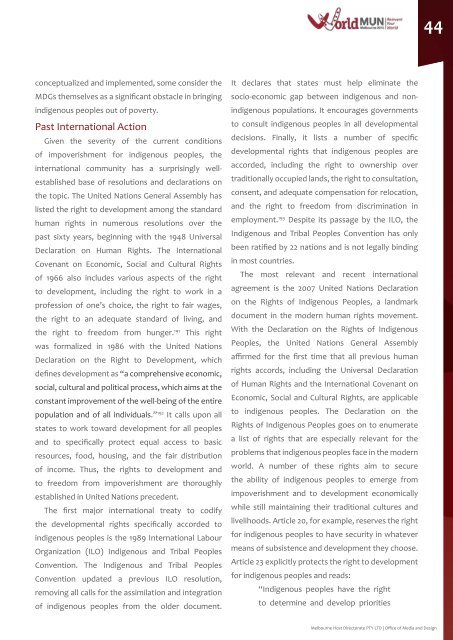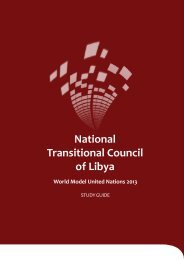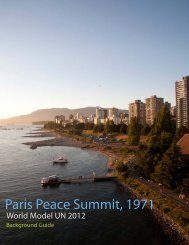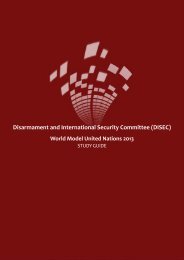Social, Humanitarian and Cultural Committee (SOCHUM)
Social, Humanitarian and Cultural Committee (SOCHUM)
Social, Humanitarian and Cultural Committee (SOCHUM)
Create successful ePaper yourself
Turn your PDF publications into a flip-book with our unique Google optimized e-Paper software.
conceptualized <strong>and</strong> implemented, some consider the<br />
MDGs themselves as a significant obstacle in bringing<br />
indigenous peoples out of poverty.<br />
Past international Action<br />
Given the severity of the current conditions<br />
of impoverishment for indigenous peoples, the<br />
international community has a surprisingly wellestablished<br />
base of resolutions <strong>and</strong> declarations on<br />
the topic. The United Nations General Assembly has<br />
listed the right to development among the st<strong>and</strong>ard<br />
human rights in numerous resolutions over the<br />
past sixty years, beginning with the 1948 Universal<br />
Declaration on Human Rights. The International<br />
Covenant on Economic, <strong>Social</strong> <strong>and</strong> <strong>Cultural</strong> Rights<br />
of 1966 also includes various aspects of the right<br />
to development, including the right to work in a<br />
profession of one’s choice, the right to fair wages,<br />
the right to an adequate st<strong>and</strong>ard of living, <strong>and</strong><br />
the right to freedom from hunger. 191 this right<br />
was formalized in 1986 with the United Nations<br />
Declaration on the Right to Development, which<br />
defines development as “a comprehensive economic,<br />
social, cultural <strong>and</strong> political process, which aims at the<br />
constant improvement of the well-being of the entire<br />
population <strong>and</strong> of all individuals.” 192 it calls upon all<br />
states to work toward development for all peoples<br />
<strong>and</strong> to specifically protect equal access to basic<br />
resources, food, housing, <strong>and</strong> the fair distribution<br />
of income. Thus, the rights to development <strong>and</strong><br />
to freedom from impoverishment are thoroughly<br />
established in United Nations precedent.<br />
The first major international treaty to codify<br />
the developmental rights specifically accorded to<br />
indigenous peoples is the 1989 International Labour<br />
Organization (ILO) Indigenous <strong>and</strong> Tribal Peoples<br />
Convention. The Indigenous <strong>and</strong> Tribal Peoples<br />
Convention updated a previous ILO resolution,<br />
removing all calls for the assimilation <strong>and</strong> integration<br />
of indigenous peoples from the older document.<br />
it declares that states must help eliminate the<br />
socio-economic gap between indigenous <strong>and</strong> nonindigenous<br />
populations. It encourages governments<br />
to consult indigenous peoples in all developmental<br />
decisions. Finally, it lists a number of specific<br />
developmental rights that indigenous peoples are<br />
accorded, including the right to ownership over<br />
traditionally occupied l<strong>and</strong>s, the right to consultation,<br />
consent, <strong>and</strong> adequate compensation for relocation,<br />
<strong>and</strong> the right to freedom from discrimination in<br />
employment. 193 Despite its passage by the ILO, the<br />
Indigenous <strong>and</strong> Tribal Peoples Convention has only<br />
been ratified by 22 nations <strong>and</strong> is not legally binding<br />
in most countries.<br />
The most relevant <strong>and</strong> recent international<br />
agreement is the 2007 united Nations declaration<br />
on the Rights of Indigenous Peoples, a l<strong>and</strong>mark<br />
document in the modern human rights movement.<br />
With the declaration on the Rights of indigenous<br />
Peoples, the United Nations General Assembly<br />
affirmed for the first time that all previous human<br />
rights accords, including the Universal Declaration<br />
of Human Rights <strong>and</strong> the International Covenant on<br />
Economic, <strong>Social</strong> <strong>and</strong> <strong>Cultural</strong> Rights, are applicable<br />
to indigenous peoples. the declaration on the<br />
Rights of indigenous Peoples goes on to enumerate<br />
a list of rights that are especially relevant for the<br />
problems that indigenous peoples face in the modern<br />
world. A number of these rights aim to secure<br />
the ability of indigenous peoples to emerge from<br />
impoverishment <strong>and</strong> to development economically<br />
while still maintaining their traditional cultures <strong>and</strong><br />
livelihoods. Article 20, for example, reserves the right<br />
for indigenous peoples to have security in whatever<br />
means of subsistence <strong>and</strong> development they choose.<br />
Article 23 explicitly protects the right to development<br />
for indigenous peoples <strong>and</strong> reads:<br />
“Indigenous peoples have the right<br />
to determine <strong>and</strong> develop priorities<br />
44<br />
Melbourne Host Directorate PTY LTD | Office of Media <strong>and</strong> Design

















